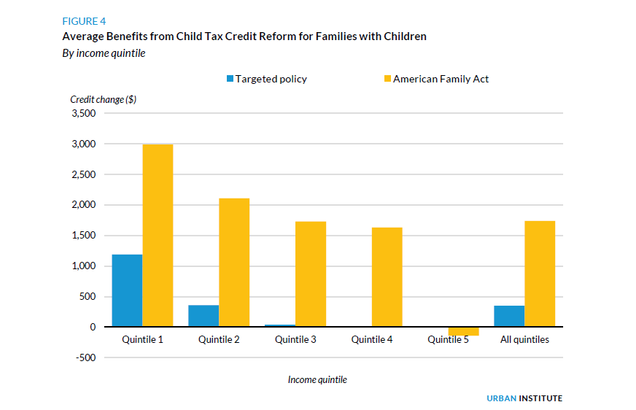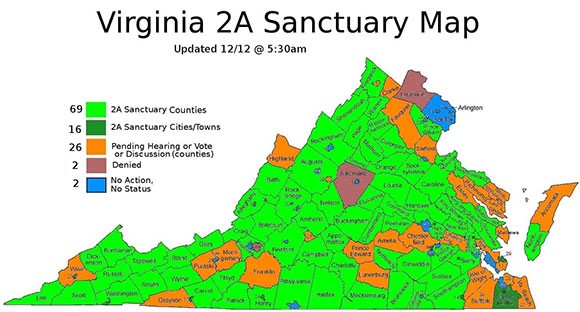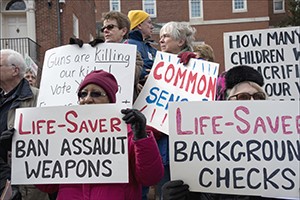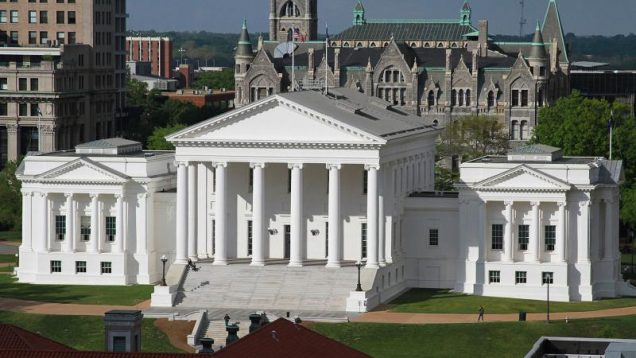Category: Federal Legislation
Time to Hang up the Boxing Gloves? The Fight Over the Johnson Amendment
Most Americans have never heard of the Johnson Amendment, never mind the nearly 70 year legal and political battle over its meaning and reach. What is the Johnson Amendment, and why is it so important to so many organizations that they have been either trying to protect or destroy it for decades? This post will attempt to explain the long-fought political battle over the Johnson Amendment.
The Johnson Amendment prohibits not for profit, or 501(c)(3), organizations from participating in politics, including restricting them from endorsing political candidates. In 1954, then-Senator Lyndon B. Johnson sponsored the amendment to the tax code after two tax-exempt organizations opposed his candidacy in the recent Texas primary. Until then, tax-exempt organizations had been extremely engaged in political activity through the country. The Johnson Amendment was relatively successful in getting tax-exempt organizations from being politically engaged, at least directly. Many organizations, however, simply have separate political branches called 501(c)(4) political action branches. 
Recently, Amendment opponents, such as Congressman Steve Scalise (R-La.) and 40 other Republican Representatives, have introduced the Free Speech Fairness Act. This bill seeks to amend the Internal Revenue Code of 1986 “to allow charitable organizations to make statements relating to political campaigns if such statements are made in the ordinary course of carrying out its tax-exempt purpose.”—effectively repealing the Johnson Amendment. If passed, it will permit 501(c)(3) tax-exempt organizations under Section 501(c)(3) to endorse or oppose political candidates without fear of losing their tax-exempt status.
Supporters of the Johnson Amendment are varied, including both secular and religious organizations. The most outspoken supporter of the amendment is the Freedom From Religion Foundation (FFRF). The FFRF and other similar organizations fear repealing the Johnson Amendment would blur the traditional line between church and state. Other religious organizations, such as the Jewish Federations of North America, oppose the FSFA because they fear getting involved with politics would tarnish the integrity of their faith. Many of these organizations, particularly the FFRF, are especially concerned about the threat of “dark money” they fear repealing the Johnson Amendment would create. “Dark money” refers to political spending by nonprofit organizations that are not required to disclose their list of donors to the IRS or the public. This hidden list of donors can be problematic as many believe this allows nonprofit organizations to receive donations in exchange for political endorsements, influence in elections, and lobbying activities. Specifically, all 501(c)(3) nonprofits, except for churches and other religious organizations, must submit Form 990 to the IRS and demonstrate how they are spending their money and how much money they are receiving (though it does not require disclosure of who the donors are). Because churches do not need to submit this form, the Freedom From Religion Foundation and other opponents of the FSFA fear the bill could lead to churches becoming unregulated Political Action Committees.
Many conservative and religious organizations, on the other hand, support the FSFA. Its biggest proponents are religious organizations such as the National Religious Broadcasters (NRB), as well as conservative organizations like the Family Research Council (FRC). The Johnson Amendment has also garnered attention from President Trump, who has promised on many occasions to eliminate it due to its restrictions on free speech for priests, pastors, and other religious organizations. These groups, the sponsors of the FSFA, and the President argue the Johnson Amendment is unconstitutional because it stifles free speech, including the ability of religious figures and organizations to openly endorse or oppose individual political candidates from the pulpit. Some groups, like the Family Research Council, even argue the Amendment restricts the content of sermons as well, a claim made in an article titled “Figures of (Free) Speech,” published on February 4, 2019, which has since been taken off of the Family Research Council website.
However, is this argument an accurate representation of the law? Does the Johnson Amendment actually stop religious leaders from preaching on topics like “life or marriage” or of “conscience and convictions,” as the Family Research Council claims? The answer seems to be no. The Johnson Amendment does not restrict churches from discussing social or moral issues with their congregations, or even from lobbying Congress. The only restriction the Johnson Amendment imposes is specifically related to candidate endorsements and/or candidate opposition. Moreover, individual priests and pastors are actually free to endorse candidates when they do so as individuals, on their own, when they are clearly speaking as private citizens and not for their religious organization.
Beyond the organizations who are vehemently opposed to the FSFA, a LifeWay poll published in 2016 found that 79% of Americans do not believe it is appropriate for pastors to endorse political candidates during a public church service.
 This, therefore, begs the question, is the repeal of the Johnson Amendment really worth fighting for year after year? Not only do the constant attacks against the amendment cost pro-Johnson Amendment organizations like the FFRF money in time and labor expended through research and lawsuits, but it similarly costs opponents of the amendment valuable donation dollars that could be put towards something more meaningful or substantial.
This, therefore, begs the question, is the repeal of the Johnson Amendment really worth fighting for year after year? Not only do the constant attacks against the amendment cost pro-Johnson Amendment organizations like the FFRF money in time and labor expended through research and lawsuits, but it similarly costs opponents of the amendment valuable donation dollars that could be put towards something more meaningful or substantial.
In 2012, Pew Research published an independent guide to the IRS rules on political activity by religious organizations. The Pew Research guide “Preaching Politics From the Pulpit: 2012 Guide to IRS Rules on Political Activity by Religious Organizations” delineates specifically what religious organizations legally can and cannot do within the context of the Johnson Amendment. According to the guide, the political campaign intervention prohibition does not restrict the discussion of any issues desired, as long as they are not linked to supporting or opposing any specific candidates, PACs, or political parties. It therefore seems that the potential gains for the freedom of speech from this bill passing would be very little compared to the thousands of dollars wasted each year on both sides of the fight on this issue.
Finally, not only is the purpose of the bill not supported by the American public, but the concerns raised by opponents of the bill are especially troubling and should certainly make everyone question whether repealing the Johnson Amendment will ultimately do more harm than good. The separation of church and state is a foundational principle of our nation, and beyond the need to protect that balance, the concern organizations like FFRF have about the potential for dark money in religious institutions seems a valid concern, particularly because they do not submit Form 990.
Ultimately, lawmakers in Washington will need to decide whether it is worth continuing to introduce this bill every year and cost both sides of the argument time and money either trying to fight or support the repeal of the Johnson Amendment.
 Kate Lipman anticipates graduating from Boston University School of Law in May 2021.
Kate Lipman anticipates graduating from Boston University School of Law in May 2021.
The Comprehensive CREDIT Act: Taking Down Credit Barriers
A pivotal financial moment, like finding a new job, buying a home, or taking out a student loan, a person's credit history can become an obstacle to achieving what they want to do. Though credit reports and scores can be effective in determining whether to lend money to a borrower, they also tend to dictate where people can work or live. The Comprehensive Credit Reporting, Enhancement, Disclosure, Innovation, and Transparency Act (“Comprehensive CREDIT Act”) would change who could use a consumer’s credit information to make determinations and what impact, and for how long, other factors could have on one’s score. Congress should enact this bill. Not only is the Fair Credit Reporting Act (“FCRA”) outdated, but credit scores also tend to perpetuate discriminatory behaviors.
Credit Reports and Scores
A credit report provides a history of a consumer’s credit activity, including bill payments, current statuses of credit accounts, and adverse records like foreclosures, bankruptcies, and civil judgments. Credit reports also provide personal information like addresses, points of contact, and the consumer’s social security number. Three companies dominate the credit reporting industry: Equifax, Experian, and TransUnion. Though they never receive a consumer’s outright consent to compile personal data, these three private companies are the main credit report providers. If there are errors on the credit report, the consumer (1) must have access to a credit report or find out about the error another way; and (2) notify the credit reporting agency rather than the creditor that reported the error. Once the consumer has done this, the credit reporting agency’s duties are triggered.
A credit score is an assessment of how likely it is a consumer will fulfill a debt obligation on time. Several factors go into determining a credit score: payment history, current debts, the types and number of accounts one currently has, how long those accounts have been open, and issues like debt collection or bankruptcy. Each of these factors, which are of varying weights, are used in a private company’s “scoring model” (i.e., a formula) to concoct a three digit number. Scores generally range from 300-850; the closer to 850, the more “creditworthy” a consumer is. Though credit reporting companies have disclosed generally which factors compose a credit score, they refuse to disclose the entire scoring model. Indeed, most use trade secret laws as a shield. Without disclosing the scoring model, credit reporting companies can engage in retaliatory and discriminatory behaviors. For example, predatory lending leads to Black and Hispanic homeowners to have higher mortgage payments. Because of historical racist policies leading to lower credit scores and less wealth among these populations, they are also more at risk of not being able to keep up with payments. The discrimination therefore feeds itself: borrowers with lower credit scores end up with even lower scores because of missed payments and foreclosures.
Who Uses Credit Scores?
Financial institutions are the biggest credit score users. Credit scores help them determine whether they should allow a consumer to obtain a line of credit or home mortgage, for example. The other major context where credit scores are important is employment. Employers conduct credit checks as part of a background check process. They usually look at the consumer’s entire credit report, not just her score. One argument is that if an individual is not “trustworthy” enough to make payments on time, they may not be trustworthy on the job, either. In certain positions, such as those involving accounting, this information would matter. But for most positions, the association between trustworthiness and creditworthiness can have prejudicial effects. (One study found that those with lower credit scores tend to have more “agreeable personalit[ies],” if anything.)
Comprehensive CREDIT Act
In January 2020, Congresswoman Ayanna Pressley (D-Mass.) introduced the Comprehensive CREDIT Act. The Comprehensive CREDIT Act, which amends the FCRA, proposes several reforms: (1) allowing for easier processes to fix credit report errors; (2) restricting use of credit scores for hiring and employment purposes; (3) providing relief for student loan borrowers with poor credit; (4) medical debt reporting wait times and bans for medically necessary procedures; and (5) reducing the amount of time adverse credit information remains on one’s credit report. Predictably, the House voted along party lines and passed the bill. However, it is now awaiting action in the Senate.
The chief reform involves what factors impact a consumer’s credit score. The Act proposes removing certain types of late payments, like student loan and medical bill payments. For the remaining delinquent or negative information, the reporting periods are shortened. For example, if an individual files for bankruptcy, the bankruptcy can appear on a person’s credit report for seven to ten years. Under the Act, the period would be shortened to four to seven years. The Comprehensive CREDIT Act also requires that when there are discrepancies in reports provided to the consumer and the requestor, those discrepancies must be explained to the consumer.
The bill also addresses credit score use for employment screening. The bill prohibits employers from denying an applicant solely because of her credit score. The bill may not go far enough, though: the employer can still request the information, and the job applicant can approve its use. While the employer’s decision cannot be made based on that information, they will nevertheless still have access to it.
The bill’s opponents say that the proposed reforms will undermine confidence in credit scores, which are integral to our financial system. By softening the impacts some credit events have, a creditor may not have the full picture of an individual’s ability to pay. The effects could harm more consumers than protect them, as riskier activity may go unreported or not have as much as a determinative effect. To be sure, credit scores are a pillar of our financial system. Any change to them will have a significant impact on how the financial impact operates. Even so, credit scores continue to have a discriminatory effect on certain communities of borrowers and only perpetuate disparate impacts. Rep. Pressley’s bill focuses largely on that impact. The purpose of the bill is to minimize the impact of credit-related issues. A credit report currently only provides a black and white picture a person’s debts and credit history; a credit score is a numeric representative of that history. It does not show that a medical debt incurred was for a life-saving procedure or that a foreclosure stems from a predatory lending process. The impacts of those events stay with the creditor for some time, further impacting their lives even though they have overcome the event. For example, a poor credit report tip the scales in favor of other candidates, especially for competitive positions.
The COVID-19 pandemic is already creating significant financial implications. Inabilities to pay credit card bills because of unexpected income losses will affect consumers for years to come, even when the financial system recovers. Because so many Americans live paycheck-to-paycheck, and because COVID-19 was largely unplanned for, consumers should not have to face the consequences. Provisions in Rep. Pressley’s bill would remedy some of those concerns. Now is clearly the time to enact the Comprehensive CREDIT Act.
 Kathryn Buckley anticipates graduating from Boston University School of Law in May 2021.
Kathryn Buckley anticipates graduating from Boston University School of Law in May 2021.
The American Family Act is both Effective Policy and Politically Viable, Let’s Make it Law
With the 2020 Democratic Primary underway, candidates are engaged in a ‘race to the left’ defined by progressive proposals for expansive federal programs aimed to combat social, economic, and environmental injustices. Underpinning these ideas is the belief in government as an effective mechanism for improving the lives of Americans and a strong rebuke of the Republican tenants that small government, deregulation, and tax cuts are the appropriate tools to lift up the impoverished, marginalized and economically struggling.
The American Family Act of 2019 (AFA) seems to be another progressive policy with noble aims, but dim prospects for bipartisan support. Most recently introduced in March 2019 by co-sponsors Senator Michael Bennet (D-CO) and Senator Sherrod Brown (D-OH), the AFA aims to reconfigure and expand the Child Tax Credit (CTC) to more effectively combat childhood poverty by increasing the financial support and removing the implicit work requirement. However, upon closer examination of its tax-focused policy structure and pro-family political implications, the AFA is distinct from other progressive Democratic proposals because it has the ability to transcend the traditional divisiveness surrounding social welfare legislation. Thus, if framed correctly and advocated for effectively, the AFA is an endangered species in today’s gridlocked and sharply divided Congress: a sweeping progressive policy with political viability.
 Enacted in 1997, and expanded since with broad bipartisan support, the CTC is an anti-poverty measure that aims to mitigate the costs of raising children through a tax deduction of up to $2,000 per year for each eligible child. The CTC is administered primarily through a non-refundable tax credit, where a family’s income tax liability is reduced by the credit value. Families without taxable income—or whose taxes are below the credit value—are excluded from taking full advantage of the credit. The CTC partially accounts for this with a refundable option for these families. However, eligibility is still subject to a taxable earnings requirement of $2500. Furthermore, refundable credits are capped at 15% of taxable income and $1400 annually. These limitations exclude the poorest and most vulnerable children from the benefit. Roughly 27 million children under seventeen are ineligible for the full credit and many don’t qualify at all. Despite its shortcomings, the CTC functions as an effective tool for alleviating child poverty, lifting one in six previously poor children and their families out of poverty each year.
Enacted in 1997, and expanded since with broad bipartisan support, the CTC is an anti-poverty measure that aims to mitigate the costs of raising children through a tax deduction of up to $2,000 per year for each eligible child. The CTC is administered primarily through a non-refundable tax credit, where a family’s income tax liability is reduced by the credit value. Families without taxable income—or whose taxes are below the credit value—are excluded from taking full advantage of the credit. The CTC partially accounts for this with a refundable option for these families. However, eligibility is still subject to a taxable earnings requirement of $2500. Furthermore, refundable credits are capped at 15% of taxable income and $1400 annually. These limitations exclude the poorest and most vulnerable children from the benefit. Roughly 27 million children under seventeen are ineligible for the full credit and many don’t qualify at all. Despite its shortcomings, the CTC functions as an effective tool for alleviating child poverty, lifting one in six previously poor children and their families out of poverty each year.
Building on the existing CTC, the AFA aims to increase its impact through five major revisions. First, it creates an expanded credit for children under six (YCTC) of $300/month ($3,600/year). Second, the AFA increases the credit for children seven though sixteen to $250/month ($3,000/year). Third, the AFA returns the upper income eligibility to pre-Trump tax levels, with phase-out beginning at $75,000 for single and $110,000 for married families. This concentrates the benefit on the poor and increasingly strapped middle-class. Fourth, and most importantly for reducing rates of childhood poverty, both credits are fully refundable, eliminating the implicit work requirement. Finally, the AFA introduces a monthly advance to “smooth families’ incomes and spending levels over the course of a year,” while preserving the fundamental structure as a refundable tax credit.
Policy analysts predict the AFA would have powerful and lasting effects on reducing childhood poverty. A report by the Columbia Population Research Center found the AFA would reduce child poverty by 38 percent, and the duel-impact of increasing the credit and eliminating the earnings requirement would move approximately 4 million children out of poverty and 1.6 million out of deep poverty. In 2015 Congress—in a bipartisan action—commissioned a group of experts to produce “a nonpartisan, evidence-based report that would provide its assessment of the most effective means for reducing child poverty by half in the next 10 years.” The report found the most impactful programs involve cash assistance to families, and noted the most effective policy for poverty reduction would be a $2,700 unrestricted child allowance, which the authors report, would alone cut child poverty by a third. Cash subsidies to low income families are also credited for increasing investment in early child development, which links to better learning outcomes and future earning potential. Thus, the AFA implements evidence-based policy for combatting child poverty and promoting broader social and economic benefits for its beneficiaries.
While much of these same benefits could be realized in other progressive policies (such as Universal Basic Income and Universal Childcare), theses government programs require strong Democratic congressional majorities. A closer examination of the political landscape surrounding tax credits and unpaid domestic labor reveals the critical ways the AFA’s form and function can attract Republican support.
To understand the bipartisan potential, we must discuss why many conservatives traditionally support the CTC. Structured fundamentally as a tax credit, the CTC can be framed as a reduction of the federal government. The CTC is more palatable than other anti-poverty initiatives because it bypasses the need for a government program with an expansive bureaucratic administration and a redistributive tax for funding. While this framework is somewhat undermined by the (partially and conditionally) refundable nature, still the CTC addresses the widely supported issue of reducing childhood poverty through an initiative that shrinks the size of the federal government by taking in less tax revenue and not offering a new administrative service. Bennet’s description of the plan demonstrates his awareness of this political tightrope. In the AFA announcement he described it as a tax cut and credit, not a benefit or allowance. When questioned on his word choice he told reporters “I think you could describe it either way.”
Republicans can also frame the CTC and the AFA expansion as pro-family. Conservatives often decry the traditional family structure is under assault and argue programs like the childcare tax credit and proposals like universal childcare structurally nudge stay-at-home parents into the workforce by discounting their unpaid domestic labor. The AFA expansion gives parity in treatment of working and stay-at-home parents. The AFA’s significant credit increase could be framed as offering a simplified and neutrally applied childcare subsidy in lieu of other universal childcare proposals, which commentators on both sides of the debate have described as disadvantaging stay-at-home parents. The Niskanen Center, a center-right think tank, supports expanding the CTC in much the same way the AFA does. It argues the increased credit should unite the left and right through its anti-poverty, pro-family message and impact. It asserts that neutral funds promote individual choice by giving parents the decision-making power to use funds to “help pay for child care for two-parent working families, or help a stay-at-home parent or a grandparent afford necessities such as diapers, transportation, access to the Internet, or educational materials for a child.” The Niskanen Center is not alone on the political right. During his campaign, Donald Trump’s Childcare Plan included a neutrally applied childcare deduction, “offering compensation for the job [stay-at-home parents are] already doing, and allowing them to choose the child care scenario that's in their best interest.” Further demonstrating the bipartisan nature of the fundamental concept and policy, Trump’s December 2017 tax plan expanded the annual CTC credit from $1000-$2000 dollars and modestly lowered the taxable income requirement.
The AFA should pass because it is good data-backed policy, but unfortunately that is not enough. It is the policy’s structure rooted in the tax code, implications supporting stay-at-home-parents, and foundation in a popular bipartisan program that give the AFA an opportunity transcend partisan gridlock and pass through congress.
 Rebecca Gottesdiener anticipates graduating from Boston University School of Law in May 2020.
Rebecca Gottesdiener anticipates graduating from Boston University School of Law in May 2020.
Sanctuaries With Guns? Turning The Rule Of Law Upside Down; by Delegate David Toscano (D-Charlottesville)
The Tazewell County, Virginia, Board of Supervisors recently jumped aboard the fast-moving “Second Amendment sanctuaries” train. In doing so, they embraced positions fundamentally at odds with state and federal constitutional law. Passing resolutions opposing certain laws or protesting governmental action is perfectly consistent with our traditions as a democracy, and no one should oppose the rights of citizens and their representatives to speak their minds. But Tazewell, and a number of other localities across Virginia, want to do much more. As Eric Young, an attorney and the county’s Administrator, put it, “our position is that Article I, Section 13, of the Constitution of Virginia reserves the right to ‘order’ militia to the localities; counties, not the state, determine what types of arms may be carried in their territory and by whom. So, we are ‘ordering’ the militia by making sure everyone can own a weapon." Other counties are announcing different schemes if gun safety laws are enacted: for example, the Culpeper County sheriff pledged to deputize “thousands of citizens” so they can own firearms.
Conservatives have railed for years against so-called “sanctuary jurisdictions,” criticizing localities that refuse to cooperate with federal immigration policies they deem heartless and ineffective. In the past year, however, some conservative lawmakers have taken a page from the progressive playbook, employing sanctuary imagery in opposition to gun safety legislation they deem to be an unconstitutional restriction of their rights under the Second Amendment.
The two approaches are classic cases of false equivalency. Jurisdictions that proclaim themselves sanctuaries for immigrants do not seek to violate the law; they simply refuse to engage local law enforcement in supporting actions that are federal responsibilities. They do not block the law, but simply insist that it should be enforced by those who have the responsibility to do so. For some proponents of so-called gun sanctuaries, however, the goal is to prevent enforcement of state law that the jurisdiction (not a court) deems unconstitutional.
After Democrats won majorities in both chambers of the Virginia General Assembly, fears of stricter gun regulations have inspired a rise in Second Amendment sanctuary activity in Virginia. Sanctuary efforts are driven mainly by the Virginia Citizens Defense League, a gun rights group to the right of the NRA. My office’s analysis of recent news accounts indicates that before November 5, just one county had passed a resolution; since the election, at least 80 localities (counties, cities, or towns) have passed some form of sanctuary resolution, and as many as 34 more are considering their adoption.
A REBELLION EMERGES
Second Amendment sanctuaries exploded onto the national scene in early 2019 after newly-elected Democratic Gov. J.B. Pritzker pledged to pass gun safety measures in Illinois. Within months, 64 of the state’s 102 counties passed sanctuary resolutions. After New Mexico expanded background checks in 2019, 30 of 33 counties declared themselves Second Amendment sanctuaries. Similar actions have either been taken or are under consideration in Colorado, Oregon, Washington state, and now Virginia.
In some cases, these resolutions simply register an objection to any infringement on gun owners’ rights. But some Virginia localities have gone further, indicating that they will not enforce state law that they deem unconstitutional. Some proponents have even resurrected words like “nullification” and “interposition,” terms first used extensively by Southern secessionists prior to the Civil War, and more recently during the “massive resistance” to federal laws requiring desegregation in the 1960s. They argue that constitutional officers in Virginia, such as Commonwealth’s Attorneys and Sheriffs, have discretion not to enforce laws that they consider “unconstitutional.” In Virginia, there has always existed some debate about the independence of these officers, but, while they are creations of the Constitution, their duties are nonetheless "prescribed by general law or special act.” In short, sheriffs may be “constitutional officers,” but they are not “constitutional interpreters.”
FLASHPOINTS IN THE CULTURE WARS
The emergence of these sanctuaries demonstrates a growing rift in our nation. For residents in many rural areas of our country, guns are viewed as part of their way of life, one some fear that they will lose due to national and state changes. Most gun owners are law-abiding citizens, and any effort to limit anyone's access to firearms is perceived as a direct attack on many things that they hold dear. During the Obama years, the manufacture and purchase of firearms increased in dramatic numbers in part due to unfounded fears that the government would try to take away guns. Voting to declare themselves “sanctuaries” is a way they can reassert some control over events that they feel are putting them at risk. For these communities, it matters little that reasonable gun safety proposals have largely passed constitutional muster, or that most proponents of these measures have no intention of taking anyone’s guns away unless it can be shown, in a court of law, that they are a danger to themselves or others.
At the same time, the general public is increasingly supportive of certain gun safety measures. An April 2018 poll found that 85 percent of registered voters support laws that would "allow the police to take guns away from people who have been found by a judge to be a danger to themselves or others" (71 percent "strongly supported"). These measures, called Emergency Risk Protection Orders (ERPO), or “red flag” laws, create judicial procedures by which persons with serious mental health challenges deemed a threat to themselves or others can have their weapons removed until their situation is resolved; courts can be engaged to protect the rights of the accused. And a March 2019 Quinnipiac poll reported that 93 percent of American voters support a bill that would require “background checks for all gun buyers.”
The energy behind support of gun measures like "red flag" laws is generated by concern for mass shootings, which are statistically rare but dramatic in their public impact, and the increasing numbers of gun-related suicides, which impact families and communities in quiet but devastating ways. On the latter front, there is a certain irony that some communities which have embraced Second Amendment sanctuary status also have higher gun suicide rates than other communities in their state. In Colorado, for example, nine of the 10 counties with the highest suicide rate over the past 10 years have declared themselves “Second Amendment sanctuaries,” many after the state passed an ERPO law in 2019. Of the 24 Colorado sanctuary counties for which suicide data is available, 22 (or 92 percent) had firearm suicide rates above the state average. Similarly, in Virginia, 36 of the 51 localities that have adopted a resolution to date and for which firearm suicide data is available have rates higher than the state median.
Recent polling in Virginia tells us that citizens of the Commonwealth are in step with the national trends documented above: Roanoke College’s Institute for Public Opinion Research recently released polling results which show that 84 percent of respondents favor universal background checks, and 74 percent support allowing a family member to seek an ERPO from a court. Yet in the very same pool of respondents, 47 percent believe it is more important to protect the right to own guns than to control gun ownership. The only way to make the math add up is to recognize that some people who strongly support Second Amendment rights may also support at least some reasonable gun safety measures—an approach the “sanctuary” advocates would never adopt. But even former Supreme Court Justice Antonin Scalia might have had problems with some of the arguments being advanced by proponents of sanctuaries. “Like most rights,” he wrote in District of Columbia et. al. v. Heller, “the right secured by the Second Amendment is not unlimited. From Blackstone through the 19th-century cases, commentators and courts routinely explained that the right was not a right to keep and carry any weapon whatsoever in any manner whatsoever and for whatever purpose." In short, rights under the Second Amendment have never been absolute. And under both the national and state Constitutions, our courts are tasked with determining the constitutionality of laws—not local sheriffs.
HOME RULE VS. DILLON RULE
Proponents of Second Amendment sanctuaries have another problem in Virginia; the Commonwealth is what we call a “Dillon Rule” state. This means that if a power is not specifically permitted to a locality, state law rules. Progressives have been especially critical of Dillon Rule arguments in years past, believing that they have prevented localities from enacting policies—from local minimum wage ordinances to gun prohibitions—that seek to go further from state law. They have rarely been concerned that more conservative localities, if granted greater “home rule,” might enact policies, such as environmental regulations or building codes, that are more lax than state law. The Second Amendment sanctuary rebellion may prompt some to reexamine their views about how much additional power should be granted to localities.
The Virginia state legislature will soon consider several major gun safety measures, and opponents will likely strongly resist; as one county supervisor has said, “[W]e need to show them a crowd like they have never seen. They need to be afraid and they should be afraid.” Legislators should always be attuned to any unintended consequences of the laws that they pass; that is one reason why we have a deliberative process before bills are passed. But to leave the determination of whether to enforce duly-passed laws totally in the hands of sheriffs and local officials with discretionary power to determine their constitutionality is to turn the rule of law upside down, and is a direct attack on republican government and the Constitution itself.
David Toscano has represented the 57th district in the Virginia House of Delegates since 2006, and from 20011-2019 Del. Toscano served as the House's Democratic Leader. His forthcoming book is titled, In the Room at the Time: Politics, Personalities, and Policies in Virginia and the Nation.
A modified version of this opinion piece appeared on Slate.com.
Stop the Clock: Implications of Switching Time Zones
The holiday season is joyous for many reasons; from family, friends, and food, there is ample joy and merriment to go around. There is one aspect of the season that doesn’t match these factors; especially in New England – darkness. At the outset of winter, on December 21st each year, the sun sets in Boston at 4:11pm. There are many negative effects of darkness setting in before the end of the workday – with increased crime, traffic accidents, and seasonal depression being one of the most paramount. Boston’s sunset is not the earliest in the area, with municipalities in Maine experiencing sunsets earlier than 4pm; but it is the earliest of the major cities, beating out Buffalo, NY despite being further south.
Early sunsets do not become apparent in New England until clocks fall back in line with the change from Daylight Savings Time. Daylight Savings is a federal program instituted during World War II that the country has become accustomed to; the federal legislation only permits states to opt out of the program, but it does not allow states to make the program permanent, which would keep the clocks from falling back an hour. Hawaii and Arizona have opted out of the program – made available through the US Energy Policy Act of 2005, allowing any state that lies entirely within one time zone to opt out.
New England states, primarily Massachusetts and Maine at this point, have been considering a change to the Atlantic Time Zone
in order to increase the number of waking hours with sunlight. With a change to Atlantic Time, and subsequent opting out daylight savings, New England would be out of sync with the rest of the Eastern Time Zone from November to March, or the period in which clocks “fall back” in line with daylight savings in the Eastern Time Zone. A transfer to Atlantic Standard Time – which includes Puerto Rico, the Virgin Islands and eastern Canada – would mean jumping an hour ahead of the Eastern time zone from November to February. The time zones would align from March to October.
While the benefits of having an extended amount of light in the evening hours are readily apparent, there are several drawbacks that accompany a change. Early risers in particular, who are likely accustomed to the sun being out while they start their days have reason to complain. School aged children may be leaving to their schools in darkness in the morning, and businesses that transact on financial markets may be put out of sync with the markets they depend on.
If New England were to change to Atlantic time, there would be a two-step process. First, the interested states would have to decide to leave. Second, the states would have to consult the US Department of Transportation, the cabinet agency that regulates time zones. States, municipalities, business interests, and others would have the opportunity to weigh in during both steps.
 There could be major issues with “commerce, trade, interstate transportation and broadcasting” if one state moves ahead one hour while its neighboring states remain in the Eastern Time Zone. It seems to be a requirement of widespread support and agreement for any change in this area to take effect. Lawmakers in Maine might support the change – in May 2017, Maine’s Senate passed a bill that would move the state to the Atlantic Time Zone — if approved by residents in a state-wide referendum. Maine conditioned the change, subject to their approval, on Massachusetts and New Hampshire.
There could be major issues with “commerce, trade, interstate transportation and broadcasting” if one state moves ahead one hour while its neighboring states remain in the Eastern Time Zone. It seems to be a requirement of widespread support and agreement for any change in this area to take effect. Lawmakers in Maine might support the change – in May 2017, Maine’s Senate passed a bill that would move the state to the Atlantic Time Zone — if approved by residents in a state-wide referendum. Maine conditioned the change, subject to their approval, on Massachusetts and New Hampshire.
Some states seem to have considered the idea and decided against it, with the New Hampshire Senate voting against a bill that would move the state to the Atlantic Time Zone by a 16 to 7 vote; at the same time, the bill passed the house with a voice vote. While there has yet to be an affirmative move, the proponents of the change are enlivened by the action around the issue and are hopeful for the future.
Massachusetts established a commission to study the issue. In a neutral report neither supporting or disavowing the change, the commission stated its findings that "People tend to shop, dine out, and engage in other commercial activities more in after-work daylight,". . . "Year-round DST could also increase the state's (competitiveness) in attracting and retaining a talented workforce by mitigating the negative effects of Massachusetts' dark winters and improving quality-of-life." More daylight could also reduce street crime, on-the-job injuries and traffic fatalities, and boost overall public health, the commission found.
States in the Northeast seem intrigued by the change, but alterations of the particulars of their citizen’s days are deeply personal to their citizens may be a drastic change to take without widespread public support. In Arizona, the effects of their non-adherence to daylights savings time are apparent when the state is out of sync with the rest of the surrounding states – constant clarification of what time is in effect, setting different meeting times, etc. Results on an individual basis are a mixed bag, with businesses that are purely local and that thrive in the daylight being supporters of the longer day due to increased business, and those who constantly run up against timing differences by virtue of dealing with other regions.
It will be interesting to observe if public support for a time zone change increases as people in New England become aware that doing so is a possibility to increase their daylight hours in the depths of winter. In any case, it is clear that the states’ legislatures have identified it as a possible issue.
 Drew Kohlmeier is a student in the Boston University School of Law Class of 2020 and is a native of Manhattan, KS, graduating with a degree in Biology from Kansas State University in 2016. Drew decided on Boston for law school due to his interest in health care and life sciences, and will be practicing in the emerging companies space focused on the life sciences industry following his graduation from BU.
Drew Kohlmeier is a student in the Boston University School of Law Class of 2020 and is a native of Manhattan, KS, graduating with a degree in Biology from Kansas State University in 2016. Drew decided on Boston for law school due to his interest in health care and life sciences, and will be practicing in the emerging companies space focused on the life sciences industry following his graduation from BU.
The US House Must Start Protecting Undocumented Minors
The 2018 midterm election should be considered less of a “blue wave” and more of a call to action made by the people of the United States to their House Representatives. The Trump administration has made many an egregious decision since 2017 and the Democrats of both the House and the Senate have unable to block such decisions due to their minority status. The Democrats must use their majority status in the House to actively combat the Trump administrations treatment of Latin American and other undocumented minors in detention.
Beginning in April 2018, Trump’s “zero tolerance” immigration policy led to the separation of infants from their mother’s arms, children from their father’s reach, and siblings from their brother’s or sister’s hands. Family separation shocked the conscience of the nation and the outcry against the policy’s ramifications drove President Trump to sign an executive order “ending” family separation. Thousands of children remained in detention, separated from their parents, for months after the executive order. In June 2018, a U.S. District Court Judge issued a preliminary injunction against the government, requiring that children be returned to their parents within 30 days. Come late October, the Department of Homeland Security still had hundreds of separated children in its custody. The government’s failure to comply with the injunction filled public discourse with calls to act to free the children. Some of the parents of these children who have been deported to the countries they fled have made the soul-churning decision to leave their children in the United States because returning the children to their country of origin could mean death. Despite the alleged “end” of the family separation policy, 81 children have been separated from their families since President Trump’s executive order.
children from their father’s reach, and siblings from their brother’s or sister’s hands. Family separation shocked the conscience of the nation and the outcry against the policy’s ramifications drove President Trump to sign an executive order “ending” family separation. Thousands of children remained in detention, separated from their parents, for months after the executive order. In June 2018, a U.S. District Court Judge issued a preliminary injunction against the government, requiring that children be returned to their parents within 30 days. Come late October, the Department of Homeland Security still had hundreds of separated children in its custody. The government’s failure to comply with the injunction filled public discourse with calls to act to free the children. Some of the parents of these children who have been deported to the countries they fled have made the soul-churning decision to leave their children in the United States because returning the children to their country of origin could mean death. Despite the alleged “end” of the family separation policy, 81 children have been separated from their families since President Trump’s executive order.
Another source of turmoil within the United States’ immigration system is the lack of representation for these children. Children, who do not speak English and are as young as 3 years old, are representing themselves against the U.S. government in immigration courts. They are being led to make decisions that are not in their best interest. For example, a 5 year old girl named Helen was told to sign her name on a form that waived away her rights to a Flores bond hearing, which would have guaranteed her a hearing in front of an immigration judge in far less time than she spent at a shelter, separated from her family. While organizations like the American Civil Liberties Union, private firms, and law school institutions are providing legal services to help bring families back together, the number of children essentially being forced to represent themselves is too high.
 The psychological toll on the detained children who were reunited with their families is immeasurable. There have been documented cases of young children, unable to understand why their parents suddenly disappeared from their lives, rejecting or distrusting their parents upon reunification. Other children live in fear of being taken again and anxiously cling to their parents. In December 2018, the nation took notice of the deaths of two undocumented children, one a 7 year old girl and the other an 8 year old boy, both from Guatemala, who died from medical complications while in Border Patrol custody.
The psychological toll on the detained children who were reunited with their families is immeasurable. There have been documented cases of young children, unable to understand why their parents suddenly disappeared from their lives, rejecting or distrusting their parents upon reunification. Other children live in fear of being taken again and anxiously cling to their parents. In December 2018, the nation took notice of the deaths of two undocumented children, one a 7 year old girl and the other an 8 year old boy, both from Guatemala, who died from medical complications while in Border Patrol custody.
More and more questions are being raised in Congress about how to address the turmoil of the Trump administration’s immigration landscape. Despite increased attention on this humanitarian crisis at the border, the problem has gotten worse over the past few months. In fact, Boston University Law Professor Sarah Sherman-Stokes reports that a team of BU Law professors and students spent a week at the border in March. They used sharpie markers to write parents' contact information on their children in case they were separated. Despite this, the Trump White House seems to be now moving toward an even harder line toward migrants; complete with a purge of Homeland Security leadership.
At this point, there should be no compromise by Democrats regarding the treatment of undocumented children and their families. Now that Democrats have a deciding vote in the House, they must use that vote, the voice their constituents gave them--and especially their oversight powers--to protect the voiceless and vulnerable children in DHS custody.
This may be finally happening. On April 17th, Elijah Cummings (D-Md.), chair of the House Oversight Committee, invited the architect of Trump's immigration policy Stephen Miller to appear before the Committee:
"I am offering you an opportunity to make your case to the Committee and the American people about why you -- and presumably President Trump -- believe it is good policy for the Trump Administration to take the actions it has, including intentionally separating immigrant children from their parents at the border to deter them from coming to the United States, transferring asylum seekers to sanctuary cities as a form of illegal retribution against your political adversaries, and firing top Administration officials who refuse orders to violate the law."
Miller is scheduled to appear before the Oversight Committee on May 1.
The safety of children should not be a partisan issue, but if anyone is going to act to ensure the safety of immigrant children, it should be the newly elected House of Representatives. The House should pressure the Senate and President to abide by the United Nation’s guidelines on the humane treatment of migrant children and their families and enforce their implementation. Any derogation leaves room for more horrifying tales of assault, abuse, trauma, and deaths of innocent children who were only trying to avoid such fates in their homelands. The House should also legislate to protect the Flores rights of unaccompanied minors and require that these minors be provided with representation in front of immigration courts.
The international community has condemned President Trump’s treatment of migrants, documented and undocumented, asylum-seeking and non-asylum-seeking, on several occasions, but some of the loudest condemnations fall upon the separation of families and treatment of children. Some governments and organizations have gone so far to call the family separation policy a humanitarian crisis and illegal. Let this moment in our nation’s history not go down as a complete humanitarian failure but as a showing of what the people can do to try and rectify the mistakes made by discriminatory policymaking.
 Cassandra Castro will graduate from Boston University School of Law in 2020.
Cassandra Castro will graduate from Boston University School of Law in 2020.
The Future of Supervised Injection Sites in Massachusetts and Beyond
With Massachusetts and the country facing a rising opioid overdose epidemic, lawmakers are looking to some controversial measures to curb overdose deaths. One of those measures being considered is supervised injection sites, also called safe injection sites or safe consumption spaces. Safe consumption spaces, of which there are 100 worldwide, are clean spaces where people can legally use pre-obtained drugs with supervision from healthcare professionals who aim to make injections as safe as possible while providing health care, counseling, and referral services to addicts. While safe injection sites have been successfully implemented in Canada, Australia, and Europe over the past 30 years, attempts to create such sites in San Francisco, Seattle, Boston, and more U.S. cities have not yet been successful. Beyond policy arguments as to whether these sites are effective, sites in the United States also face significant legal hurdles under federal law.
According to supporters of safe injection sites around the country and the world, the policy is an effective and relatively low-cost way to prevent overdose deaths and manage harm with no demonstrated consequences of increased drug use or increased crime. Opponents of safe injection sites, including Massachusetts Governor Charlie Baker, have pointed to increased opioid deaths in
recent years in Vancouver, which established its supervised consumption site Insite in 2003, to argue that safe injection sites are not actually effective in preventing overdose deaths. However, those arguments are misleading, as experts have stated that the increase in overdose deaths in Vancouver are due to the influx of fentanyl being added to drugs, and that Insite actually saw a 35% reduction in overdose deaths around the facility in the two years after it opened. While there are also studies questioning the efficacy of safe consumption sites—calling into question whether they have a significant impact on reducing deaths and reaching a significant amount of drug users—even the negative studies generally criticize safe consumption sites as being relatively ineffective as opposed to actively harmful. There are dozens of peer-reviewed scientific studies that have found that safe injection sites actually do significantly benefit those who are addicted to opioids and prevent opioid deaths. Notably, no death has ever been reported in an injection site, and a review of studies concluded that injection sites were associated with less outdoor drug use and did not appear to have any negative impacts on crime or drug use.
Despite the strong evidence backing the societal benefits of implementing and supporting safe injection sites, the policy faces significant legal and political obstacles in the United States. Perhaps the biggest hurdle that advocates of safe injection sites face is the potential legal liability of such sites under federal law and opposition from the Justice Department. The Controlled Substances Act makes it illegal to “knowingly open, lease, rent, use, or maintain any place, whether permanently or temporarily, for the purpose of manufacturing, distributing, or using any controlled substance,” as well as to knowingly manage such a place. The plain language of that law may render implementation of safe injection sites impossible without some change or exception carved out in federal law.
 However, advocates of safe injection sites do have a glimmer of hope that, once the first U.S. site is created, it will pass judicial muster through a creative legal argument proposed by law professor and drug policy expert Alex Kreit. In his paper, Kriet argues that a provision in the Controlled Substances Act providing immunity to state and local officials who commit drug crimes while enforcing local laws could protect safe injection sites from a crackdown by the federal government. Kreit has stated that the infrequently cited rule has previously been used in situations where authorities have seized marijuana and then returned it in states where marijuana has been legalized. Under this theory, those involved in safe injection sites would be protected so long as they were acting in accordance with a city ordinance or state law supporting safe injection sites. Other experts have expressed skepticism that such an argument would pass muster, however, with some stating that Kreit’s argument is a “stretch,” and that any path toward legality for safe injection sites lies in convincing the federal government not to target safe injection sites on public health grounds.
However, advocates of safe injection sites do have a glimmer of hope that, once the first U.S. site is created, it will pass judicial muster through a creative legal argument proposed by law professor and drug policy expert Alex Kreit. In his paper, Kriet argues that a provision in the Controlled Substances Act providing immunity to state and local officials who commit drug crimes while enforcing local laws could protect safe injection sites from a crackdown by the federal government. Kreit has stated that the infrequently cited rule has previously been used in situations where authorities have seized marijuana and then returned it in states where marijuana has been legalized. Under this theory, those involved in safe injection sites would be protected so long as they were acting in accordance with a city ordinance or state law supporting safe injection sites. Other experts have expressed skepticism that such an argument would pass muster, however, with some stating that Kreit’s argument is a “stretch,” and that any path toward legality for safe injection sites lies in convincing the federal government not to target safe injection sites on public health grounds.
If cities and states cannot find a legal workaround protecting those involved with the safe injection sites, advocates likely face an uphill battle in convincing their communities and the Justice Department to accept injection sites. Attempts at establishing sites have not been politically palatable, as demonstrated by efforts in San Francisco and Boston. California Governor Jerry Brown vetoed a bill that would have allowed supervised drug consumption sites in the state and went so far as to describe it as “enabling illegal drug use.” In Massachusetts, in addition to Governor Baker’s opposition to the idea of safe injection sites, the Senate ultimately stripped a provision authorizing safe injection sites from its comprehensive opioid bill this past legislative session, instead replacing the pilot program with a commission to study the feasibility of establishing such sites. In addition to opposition from state Governors and a lack of strong state government support, it seems highly unlikely that the current federal administration would turn a blind eye to safe injection sites on public health grounds. In addition to a statement from the Vermont U.S. Attorney’s Office criticizing the policy and affirming that the United States Attorney would impose ramifications under federal law, there have been multiple other instances indicating the administration’s hostility towards safe injection sites and similar policies. In August, Deputy Attorney General Rod Rosenstein wrote an op-ed in the New York Times opposing safe injection sites and emphasizing the fact that they violate federal law. The Justice Department also “promise[d] [a] crackdown” on supervised injection facilities on an NPR radio show.
While there is scientific and global community support for safe injection sites, their future in the United States is still unclear, especially under the current federal administration. Until there are more assurances that sites could operate without intervention from federal law enforcement, it seems that most cities and states that have been at the forefront of the push for safe injection sites do not have the political will or capital to open the country’s first site and become the guinea pig of the movement. Philadelphia, however, may be the one city willing to go first. In August, Philadelphia Health Commissioner Dr. Thomas Farley said that Rosenstein’s opposition and warnings from the Justice Department would not prevent Philadelphia officials from further exploring the idea. Currently, Philadelphia seems to be going forward with its plan to allow, but not publicly fund, a non-profit site called Safehouse, which could serve as a jumping off point for litigation determining the legality of the sites and potentially creating more certainty for other interested cities and states. As for Massachusetts, it seems unlikely that the Commonwealth will be establishing any safe injection sites in the near future, though the members of the commission created in last session’s opioid bill will no doubt keep a close eye on Philadelphia as its safe injection site plan comes to fruition.
Curbing Medicare Drug Costs
Prescription drug spend in the U.S. is the highest in the world. Americans pay up to three times the amount per capita of other countries. This is problematic for our growing aging population since their income becomes limited. While Medicare covers prescription drug costs, there are policy gaps that make it unaffordable. One major barrier to price controls is part D of title XVIII of the Social Security Act, in which explicitly prohibits the federal government “from negotiating directly with pharmaceutical companies to lower drug prices”. President Donald Trump proposed several policies to reduce the cost burden of prescription drugs on consumers through free-market competition approach, focusing mainly on cost transparency and promoting use of biosimilar or generic drugs. The policies are praised as a “small step in the right direction”. Yet, many Americans are dissatisfied since the proposals do not include direct Medicare negotiations with drug manufacturers. Pharmaceuticals argue that price controls would strain their investments in research and development (R&D) of new drugs. After taking a closer look, that is not fully the case. Greater price control measures can be taken, but there must be political will to support it. For now, the President’s policies are a small victory for seniors across America.
Medicare Coverage Today
Prescription drugs are covered under Medicare Part A, B, and C plans, but to a limited capacity. Part A is hospital insurance, part B is traditional medical insurance, and part C (Medicare Advantage) is like a health maintenance organization (HMO) or preferred provider organization (PPO) plan type. Only drugs administered within these respective settings are covered. Because of these limitations, the Medicare Modernization Act of 2003 was enacted, creating Medicare part D drug benefit.
Part D is an “optional” supplemental insurance that can be purchased with any of the other Medicare plans. It, however, is severely flawed. First, Congress did not commit any financing for part D, leaving costs falling on the recipient. Second, and most notoriously, is the “donut hole” coverage gap between initial enrollment and a “catastrophic coverage threshold”. The entry-point coverage limit is currently $3,750. Once this amount is reached, the patient is then responsible for fully paying for their medication until the maximum amount of the out-of-pocket (OOP) costs have been paid, or the annual time period lapsed. The OOP threshold now is $5,100, unaffordable for many seniors that suffer multiple chronic conditions.
Additionally, the plan disincentivizes patients from purchasing brand name drugs by increasing patient coinsurance payments. Provisions of the Affordable Care Act attempted to close this gap by 2020 by limiting patient payments to 25% of the gap. Under the Trump Administration, the Bipartisan Budget Act of 2018 advanced that date to 2019. Another caveat to Part D is that it is not really “optional”. If an individual fails to sign up once qualified and decides to enroll later, they will pay penalty fees for as long as they are on part D, with the exception of a few circumstances, such as having drug coverage from an employer.
The President’s Policies
To mitigate the Medicare drug coverage issues, the Trump Administration released his “blueprint” rules and policies, supplemental to the Bipartisan Budget Act. Provisions that went into effect include:
- “Step therapy” rule within the Medicare Advantage plans- clinicians are to prescribe cheaper drugs and monitor patient progress closely. If the drug is found to be ineffective, then a clinician can prescribe the next expensive drug. Clinicians in the Advantage plan get commission for the drugs they provide. The rationale is to curb physicians from “gaming” for greater profits. This rule is now in effect.
- Taking harder action, the President recently signed legislation to ban “gag clauses” that prevented pharmacists from disclosing the best drug prices with customers. This is helpful for those who may be in the coverage gap of part D and would have to pay full price of the drug.
Other policies proposed and will likely be revisited for the upcoming session include:
- Limiting doctor’s offices to charge consumer price index (CPI) of drugs administered in their office.
- Shifting drugs from part B to D to promote greater market competition among drug makers to lower prices.
- Allowing drug rebates to go to the consumer rather than the healthcare provider or health plan.
- Promoting the use of biosimilars and generic biotechnology drugs.
- Closing loopholes, such as the 180-day exclusivity that allow brand-name drug companies to “game” Food and Drug Administration (FDA) rules in ways that hinder generic competition.
- Requiring drug manufacturers to disclose list prices in their advertisements.
These policies are a great step towards drug price controls. Yet, many argue that true price controls could only be achieved by allowing Medicare to directly negotiate drug prices. Perhaps that may be the case, as demonstrated by many other rich democracies. Pharmaceuticals, however, dispute this on the grounds that it would limit R&D investments.
In a recent study, Yu et al. evaluated the “top 15 drug companies in 2015” and found that the inflated prices are not justified by the R&D costs. Securities and Exchange Commission (SEC) laws and regulations require all public holding companies to publically disclose their financial statements. Knowing this, I reviewed the 2017 financial report of the largest pharmaceutical company in the world, Pfizer. Their R&D costs were $7.7 billion and accounted for 14.7% of their reported revenue of $52.5 billion. After discounting other expenses, their net income was $21.4 billion, allowing them to maintain 40.6% in profits. These figures are not uncommon. According to the International Trade Association, 15-20% of gross revenues is how much U.S. pharmaceutical companies spend on average on R&D (with the exception of the few that price gouged). In other countries, the R&D investments are much less, but drug costs are also lower.
Given these figures, it is of no surprise that advocates for better price controls are not convinced that R&Ds should be the main reason to maintain the inflated drug costs. Cost-effectiveness analysis (CEAs) may help determine the value of the drug, however it would likely, by default, favor biosimilars and generic drugs. In that case, the promotion of these drugs employed by the Federal government serve as a cost-effectiveness measure to some extent. For drugs that treat severe progressive conditions, such as Alzheimer’s disease or multiple sclerosis, it may be difficult to ascertain a value on new treatments since outcomes are unique to a patient’s condition. Moreover, measures involved in formal CEAs are derived from nationally administered quality/disability-adjusted life-year (Q/D-ALY) surveys of healthy people, thus not capturing the value of the treatment for those who are ill.
The President’s policies may not be perfect, but it is an experiment worth trying. Prior policies that attempted to “assist” our elderly population have failed, leaving those with chronic conditions and limited incomes forgoing treatment due to the high cost. For advocates of government price-fixing, it is important to keep in mind how much will prices be limited to, and it would likely require government to subsidize a portion of R&Ds. It is difficult to imagine that government would be willing to make such an investment if they are barely subsidizing part D costs.
Sarah Zahakos, MPH is working toward a PhD in Health Law, Policy & Management at the Boston University School of Public Health.
AHRQ T32 Research Fellow
Training in Health Services Research for Vulnerable Populations
Grant # 2T32HS022242
References
• Bartlett, B. (2013, November 13). Medicare Part D: Republican budget-busting. New York Times. Retrieved from https://economix.blogs.nytimes.com/2013/11/19/medicare-part-d-republican-budget-busting/
• Centers for Disease Control and Prevention (2018, November 15). Cost-effectiveness nalysis: Outcomes in natural units. Retrieved from
Cubanski, J., Koma, W., Damico, A., and Neuman, T. (November 19, 2018). Medicare: ow many seniors live in poverty? Henry J. Kaiser Family Foundation. Retrieved from https://www.kff.org/medicare/issue-brief/how-many-seniors-live-in-poverty/
eHealth (2018, November 16). HMO insurance plans. Retrieved from:
https://www.ehealthinsurance.com/health-plans/hmo
eHealth (2018, November 16). PPO insurance plans. Retrieved from
https://www.ehealthinsurance.com/health-plans/ppo
Food and Drug Administration (FDA) [2018, November 15]. Biosimilar and interchangeable products. Retrieved from
Hederman, Jr., R.S. (2018, August 11). New Medicare drug pricing rule — a small 'step' in the right direction. The Hill. Retrieved from
H.R.1 - Medicare Prescription Drug, Improvement, and Modernization Act of 2003.
Retrieved from https://www.congress.gov/bill/108th-congress/house-bill/1
International Trade Association (2018, November 15). 2016 top markets report
pharmaceuticals. Retrieved from
https://www.trade.gov/topmarkets/pdf/Pharmaceuticals_Executive_Summary.pdf
Kaiser Family Foundation (2018, October 12). An overview of the Medicare Part D
prescription drug benefit. Retrieved from https://www.kff.org/medicare/fact-sheet/an-overview-of-the-medicare-part-d-prescription-drug-benefit/
Lagasse, J. (2018, September 13). Most Americans disapprove of how Trump, Congress
are addressing prescription drug costs, poll shows. Retrieved from
Medicare.gov (2018, November 15). How to get drug coverage. Retrieved from
https://www.medicare.gov/index.php/drug-coverage-part-d/how-to-get-drug-coverage
Moeller, P. (2018, February 14). President Trump signed these Medicare changes into
law. Here’s what to watch for. PBS. Retrieved from
National Opinion Research Center (NORC) at the University of Chicago (2018, November
15). What should be done about the high cost of prescription drugs? Retrieved from
Part D of title XVIII of the Social Security Act. Retrieved from
Pear, R. (2018, October 10). Trump signs new laws aimed at drug costs and battles
democrats on Medicare. New York Times. Retrieved from
https://www.nytimes.com/2018/10/10/us/politics/trump-health-insurance-drug-costs.html
Pearl, R. (2018, September 24). The immorality of prescription drug pricing in America.
Forbes. Retrieved from
https://www.forbes.com/sites/robertpearl/2018/09/24/nostrum/#614ba37a4fb1
Pfizer (2018, November 15). 2017 financial report. Retrieved from
https://s21.q4cdn.com/317678438/files/doc_financials/Annual/2017/Financial-Report-2017.pdf
Securities and Exchange Commission (2018, November 16). Rules and regulations for
the Securities and Exchange Commission and major securities laws. Retrieved from https://www.sec.gov/about/laws/secrulesregs.htm
Sarnak, D.O., Squires, D., & Bishop, S. (2017, October 5). Paying for prescription drugs
around the World: Why is the U.S. an outlier? Commonwealth Fund. Retrieved from
Trump Administration (2018, May 30). American patients first: The Trump Administration
blueprint to lower drug prices and reduce out-of-pocket costs. Retrieved from https://www.hhs.gov/sites/default/files/AmericanPatientsFirst.pdf
Yu, N.L., Helms, Z., & Bach, P.B. (2017). R&D costs for pharmaceutical companies do
not explain elevated US drug prices. Health Affairs.
doi: 10.1377/hblog20170307.059036
Raising the Blinds – Gaining Meaningful Insight into Pharmaceutical Pricing through Legislation
Rising healthcare costs are a growing concern across the United States; in 2016 U.S. health care spending was $10,348 per person – or 17.9 % of the nation’s Gross Domestic Product (GDP). To counter this alarming rise in healthcare costs, states are addressing one of the largest factors in rising healthcare costs – high drug prices.
Many factors contribute to the high price of healthcare in our country, some of which are natural to an aging populace due to the baby boom of the 1950’s as the proportion of the population that is 65 and over is projected to experience a large increase in the coming years. An increase in costs is natural with a larger number of consumers – addressing this change is an important, but avoidable, challenge to overcome.
One avoidable factor of increasing healthcare costs is rapidly increasing pharmaceutical prices. Variance in drug prices may be geographic; based on where the drug is sold , or whom the drug is being sold to (pharmacy v. government). Many factors contribute to price differences, but an important factor are Pharmacy Benefit Managers (PBMs) as an intermediate in the market. States have been working to roll back the PBM layer of the market for the pharmaceutical industry.
Pharmaceutical pricing has long been the target of legislators, but with a lot of talk and a surprising lack of action. Drug pricing is discussed in both major party’s campaign platforms of the major parties and has been featured prominently in speeches by President Trump, and has featured in initiatives by previous administrations. There has been an uptick of legislation passed in the past decade, at all levels of government, with state action against pharmacy benefit managers and President Trump’s signing the Know the Lowest Price Act and the Patient Right to Know Drug Prices Act. A common thread in the legislation is increased transparency because a big factor in the high drug prices — and medical care generally—is the lack of information for consumers and purchasers. Since 2015, California, Oregon, Louisiana, Nevada, Vermont, Connecticut, and Maryland imposed reporting requirements on pharmaceutical manufacturers who increase prices over an established threshold in a set time period. For example, California requires reporting when a drug that costs more than $40 and its wholesale acquisition cost (WAC) increases by more than 16% over two calendar years. The WAC is similar to a “list” price for pharmaceuticals to wholesalers and direct purchasers. The WAC, however, does not include discounts or rebates offered by pharmacy benefit managers.
The new transparency offers insight to price increases; if there are no legitimate reason for the increase other than higher profits due to market control, state officials, drug customers and the public can take action.
The states with transparency statutes have imposed different methodologies with manufacturers reporting to different government officials such as the Department of Health and Human Services, creation of new departments, or to the state’s Attorney General.
Oregon currently requires the most detailed reporting; manufacturers must report to the Department of Consumer and Business Services the following:
- Name, price of drug and net increase in price (in %) over previous calendar year
- Length of time on market
- Factors contributing to price increase
- Name(s) of any generic version(s) of the drug
- Research & Develop Costs from Public Funds
- Direct costs to Manufacturer
- Total sales revenue for drug over prev. calendar year
- Profit from drug over previous calendar year
- Drug's price at release and yearly increases over the past 5 years
- 10 highest prices paid for the drug during past year outside of the US
- Any other info relevant to price increase
- Supporting documentation
In contrast, California’s requirements provide for advance notice of price increases and unearthing the reasoning for the increase. The California law requires manufacturers to report (A) Date of increase, current WAC, and future increase in WAC (in dollar amounts); and (B) The change or improvement, if any, that necessitates the price increase. Purchasers then have notice of any forthcoming price changes and if the increase is warranted. California also requires a report for new drugs if its price exceed $670—the 2017 Medicare Part D threshold. California’s reporting scheme has been a model for other states.
Maryland’s approach was more severe, with a provision banning “price gouging” of generic drugs. An “unconscionable price increase” of any “essential off-patent or generic drug” is illegal and Maryland can levy a fine and take action to reverse the price change. The state did not include any limitation of the law to drugs that have come into or passed through Maryland.
The generic drug lobby, the Association for Accessible Medicines, challenged the law and the Fourth Circuit Court of Appeals struck down the law as an unconstitutional regulation of interstate commerce. Maryland has petitioned the Supreme Court to revisit the case.
 The Pharmaceutical Research and Manufacturers (PhRMA), one of the largest pharmaceutical lobbying groups, has sued California alleging the law, like Maryland’s, is unconstitutional. Because California’s law is informational—and does not allow forced price changes—it is likely constitutional. In fact, PhRMA’s initial complaint was dismissed, and subsequently filed an amended complaint on Sept. 18, 2018.
The Pharmaceutical Research and Manufacturers (PhRMA), one of the largest pharmaceutical lobbying groups, has sued California alleging the law, like Maryland’s, is unconstitutional. Because California’s law is informational—and does not allow forced price changes—it is likely constitutional. In fact, PhRMA’s initial complaint was dismissed, and subsequently filed an amended complaint on Sept. 18, 2018.
It will be imperative for states seeking to regulate pharmaceutical manufacturers to observe where courts determine the extent of reporting they may require when they go after a manufacturer for increasing the price of their drug. For the time being, it appears that information-gathering may be the easiest available avenue for states seeking to curtail increases in drug prices. Seeking justifications and reasoning for large increases in drug prices may create a barrier for pharmacuetical companies seeking to impose unsubstantiated increases in drugs. Going further towards affirmative control of pricing appears to be off limits to states going as far as Maryland, but more careful structuring of the controls to the specific state may be permissible.
 Drew Kohlmeier is a student in the Boston University School of Law Class of 2020 and is a native of Manhattan, KS, graduating with a degree in Biology from Kansas State University in 2016. Drew decided on Boston for law school due to his interest in health care and life sciences, and will be practicing in the emerging companies space focused on the life sciences industry following his graduation from BU.
Drew Kohlmeier is a student in the Boston University School of Law Class of 2020 and is a native of Manhattan, KS, graduating with a degree in Biology from Kansas State University in 2016. Drew decided on Boston for law school due to his interest in health care and life sciences, and will be practicing in the emerging companies space focused on the life sciences industry following his graduation from BU.
Of Migration and Refugees: The Failure of Republican Deterrence Policy
Despite two years of the Trump administration’s get-tough-on-refugees policy, the latest statistics continue to show record numbers of migrants crossing the U.S. border, with “16,658 family members in September, the highest one-month total on record and an 80 percent increase from July.” This is just the latest in the periodic reports showing that Trump’s immigration policy has failed, which should prompt questions both about why it has failed, as well as why Trump continues to insist on such a patently immoral approach to policy. Since at least 2014, Republicans have pushed for draconian treatment of border-crossers on the theory that such treatment will deter people from entering the United States. However, deterennce ignores the reasons why people are fleeing their home countries, and thus predictably fails, suggesting that the G.O.P. has adopted the policy in order to appeal to a segment of the voting public whose fear and hate have been amplified by right-wing propaganda.
Shortly after taking office, Trump quickly began to make good on his campaign promises to get tough on immigration, reversing what he termed Democrats’ soft approach. These policies included the end of Obama’s Deferred Action for Childhood Arrivals program, the end of Temporary Protected Status for hundreds of thousands of people, and the implementation of harsh treatment of immigration detainees at the border, including family separation, prolonged detention of asylum-seekers, the use of prisons as “detention” facilities, and a concentration of resources to increase prosecute border-crossers (and significant evidence of over-enforcement). The goal of such policies is apparently rooted in a belief that such policies will deter migrants from attempting to enter the United States, notwithstanding the lack of evidence that such deterrence is effective.
These policies should be seen as derivative of the rhetoric of Republican critics of President Obama’s initial response to the so-called “surge” of children crossing the border in 2014. In early June, Obama originally declared the situation a “humanitarian crisis” and directed officials to apprehend and provide care, including housing and medical treatment, and legal aid. However, with right-wing propaganda outlets such as The Daily Caller whipping up fear of the children at the border, Republican politicians seized on the opportunity to make the humanitarian crisis into a political one. Claiming the crisis was due a failure of the Obama administration, politicians such as House Judiciary Chair Robert Goodlatte suggested that the solution was simply an end to “Obama’s lax immigration enforcement policies” and rigorous enforcement of the immigration laws. And, by the end of June, the Obama administration, feeling the pressure from the right, shifted gears and adopted a policy of deterrence. This crackdown included increased enforcement and wide-spread use of detention centers, as well as an information campaign “to send a clear message to potential migrants so that they understand the significant dangers of this journey and what they will experience in the United States.” This created little political traction for Democrats, as Republicans insisted that it was too little, too late, and that draconian deterrence measures were necessary.
The reality is that migration to the United States from Central America is largely driven by push factors forcing people out of their home countries, not pull factors luring them to the United States, which explains the lack of evidence for the efficacy of deterrence. As a worker at a migrant shelter in Tucson, Arizona is reported as explaining, “Why would you undertake such a dangerous journey? When you’ve got a gun to your head, people threatening to rape your daughter, extort your business, force your son to work for the cartels. What would you do?” While Trump insists on depicting migrants from Central America as gang-members, or even soldiers “sent” by their home countries in a mythical war on American interests, it is probably best to think of human beings fleeing their nations because of violence as asylum-seekers.
The Refugee Act of 1980 defines refugees and asylum-seekers to be those who are persecuted, or have “a well-founded fear of persecution[,] on account of race, religion, nationality, membership in a particular social group, or political opinion.” The law also provides a right to any alien within the United States to seek asylum, requiring those seeking such status to cross the border. Trump appears to see asylum, one of the basic pillars of human rights law, as a loophole to be exploited by evildoers, and is seeking to close that “loophole,” if not through legislation, then through deterring those seeking safe-harbor. Trump’s Justice Department, has moved to exclude domestic violence and gang targeting as bases for establishing persecution based on membership in a particular social group, overturning Board of Immigration Appeals precedent. On a moral level, there seems little reason to distinguish between the persecution faced by political dissidents in totalitarian regimes, and that faced by victims of the reign of terror perpetrated by gangs in Central America. Certainly, the pervasive fear of violence under both regimes is what drives people to seek safety in other countries. It is this push-factor, the pervasive violence faced by many Central Americans in their home nations, that is driving migration to the United States, and no amount of deterrence, short of recreating the violence of their home nations at the American border, will change the minds of those who feel forced to flee for their lives.
That said, as Trump is able to feed on fear and hate in order to build political power with his Republican base, it is unlikely that evidence-based policy arguments about the efficacy of deterrence policy will make much headway towards a reconsideration of said policy. Perhaps a congressional re-imagination made possible by the new Democratic House majority will lead to legislative changes prompting a humane response to what is at base a humanitarian crisis. The House leadership’s recent refusal to appropriate money for what many consider a boondoggle border wall suggests that Democrats are eager to pass sensible border policy rather than acquiesce to Trump’s grandstanding. Congressional mandates that the executive branch again consider domestic violence and gang intimidation as possible bases in the determination of asylum would be a start. Shifting resources from detention centers to asylum officers and immigration judges, thereby treating asylum-seekers as asylees and not felons would help as well. And, in the long-run, Congress should consider how best to address the push factors causing people to flee for their lives in the first place.
 Dan Ordorica anticipates earning his Juris Doctor from Boston University School of Law in May 2019.
Dan Ordorica anticipates earning his Juris Doctor from Boston University School of Law in May 2019.








